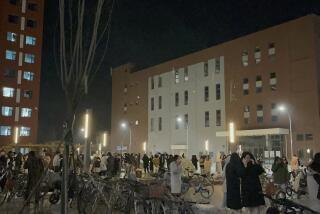Gas Explosion in China Coal Mine Kills 203
- Share via
BEIJING — A gas explosion ripped through a shaft 800 feet below the surface Monday in Liaoning province, killing 203 men in China’s deadliest coal mine accident in half a century, the government reported today.
The cause of the 3 p.m. blast at the Sunjiawan mine is under investigation, said the New China News Agency. Twenty-two people were injured and 13 were still trapped underground.
“We think hardly anyone will come out alive,” said a local resident who gave only the name Dong. “The people working in this mine are migrants from all over the country. My neighbor’s son died down there, but there are no bodies yet since everything is buried.”
Residents said people from miles around rushed to the mine at the town of Fuxin to help rescue friends and relatives, despite the unlikely prospect of many survivors. Officials at Fuxin Coal Industry Group, owner of the state mine, said all top officers were at the site, and production had all but halted. The mine, about 100 miles west of Shenyang in one of China’s oldest coal mining regions, can produce 1.5 million tons annually.
China has suffered a spate of deadly mining accidents in recent months, despite a high- profile campaign to close smaller mines and improve safety standards in existing ones. This is the worst reported accident since Communist rule began in 1949.
Many mine owners have been accused of putting profits before safety. China produces about 35% of the world’s coal but accounts for 80% of coal-mining- related deaths, according to government figures. Last year, more than 6,000 Chinese died in floods, explosions and fires in the shafts.
After each major accident, China issues warnings and mounts public campaigns on the need for greater safety.
“Every year this seems to be the No. 1 issue at various meetings,” said Kang Wu, China director at Fesharaki Associates, an energy consulting firm in Honolulu. “But on the local level, the economic pressure is very high.”
In 2003 and 2004, coal production and energy use grew more than 12% annually as the country struggled to supply a booming economy. No immediate letup is in sight. If China really wants to address its mining safety problem, analysts say, it needs to introduce expensive safety equipment, but that will raise energy prices and reduce economic growth. This is a trade-off the country has so far been reluctant to make.
Coal accounts for 69.2% of China’s primary energy needs, and much of it is produced on the backs of desperate farmers and migrant workers with few other job options.
The world’s deadliest reported mining disaster happened in 1942 in Japanese- occupied Manchuria, when more than 1,500 miners were killed.
Bu Yang in The Times’ Beijing Bureau contributed to this report.
More to Read
Sign up for Essential California
The most important California stories and recommendations in your inbox every morning.
You may occasionally receive promotional content from the Los Angeles Times.










